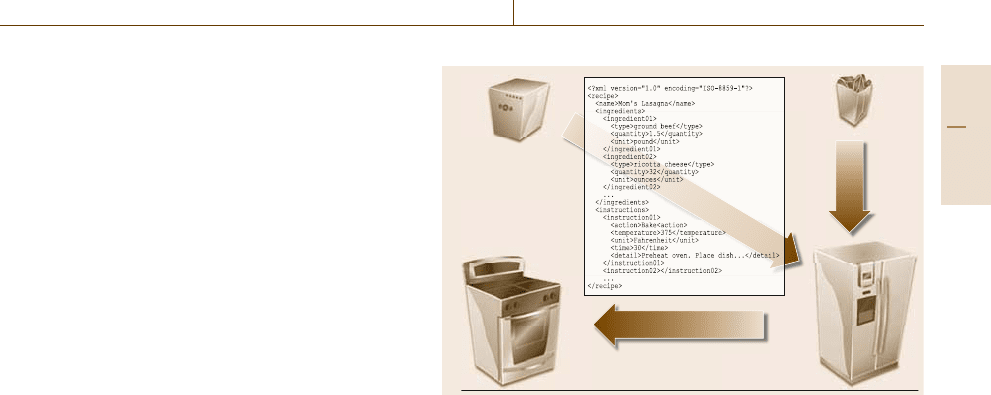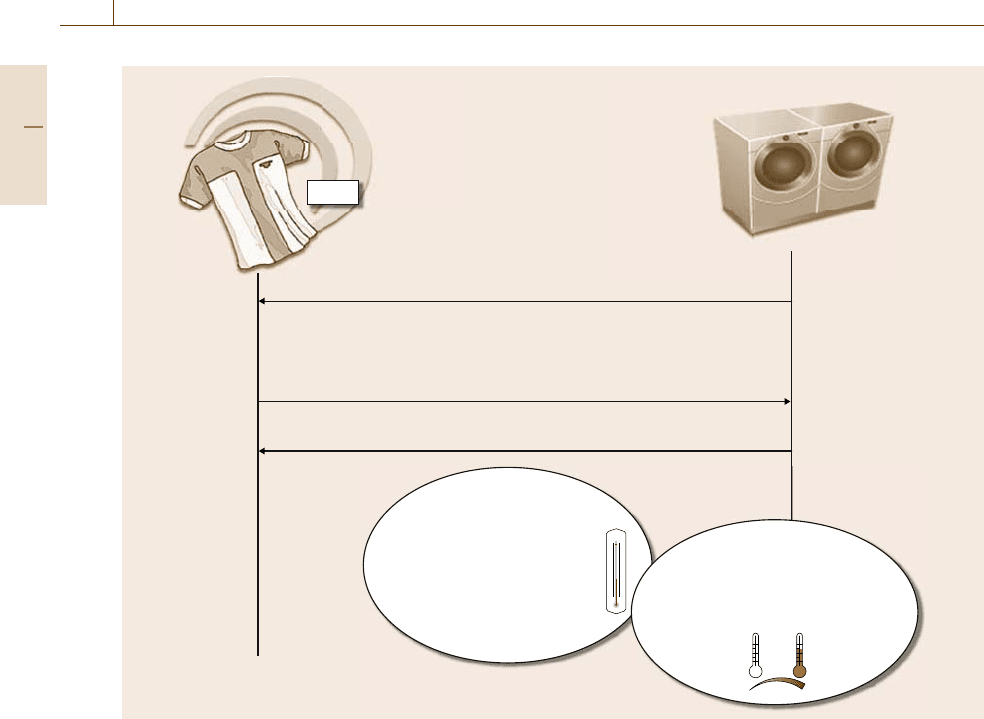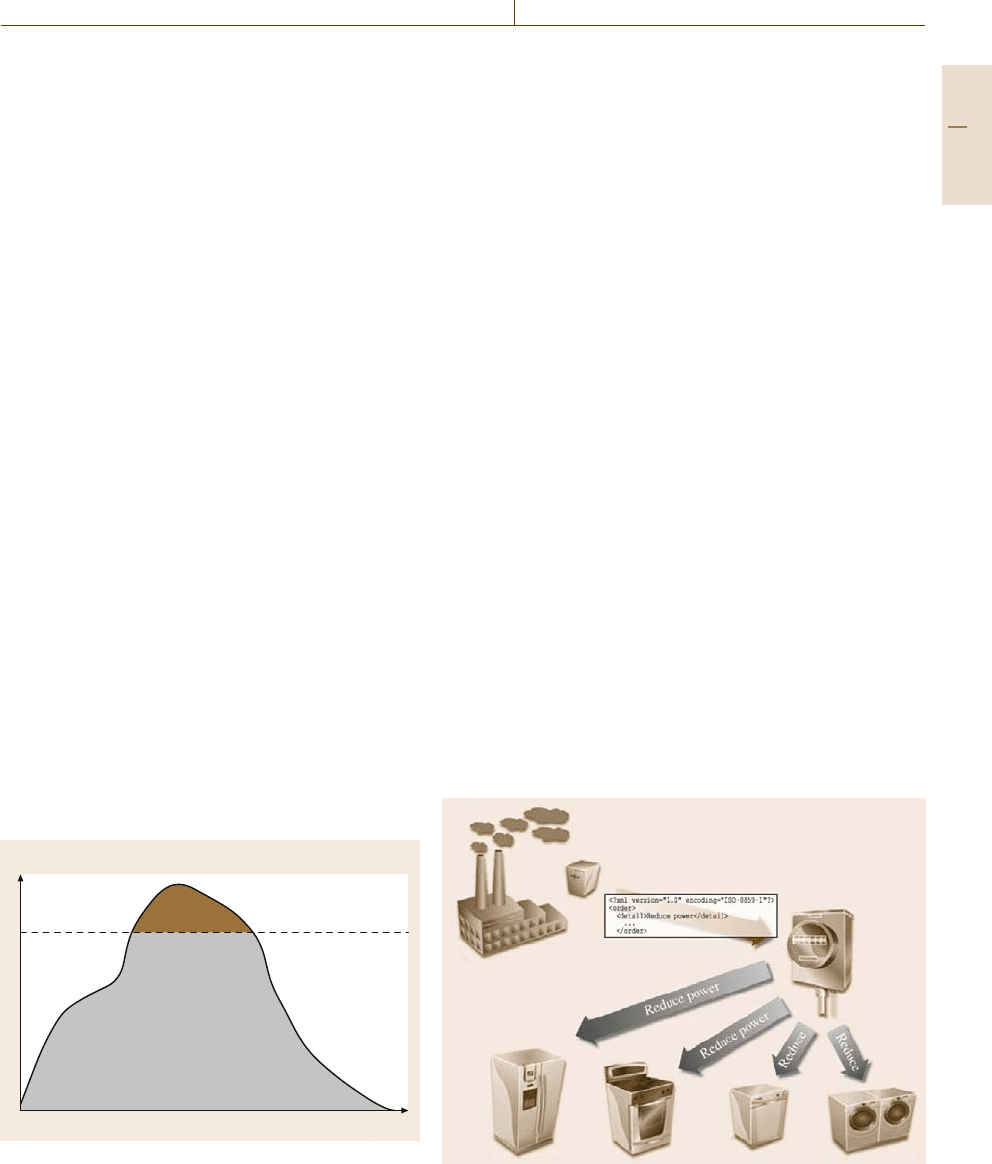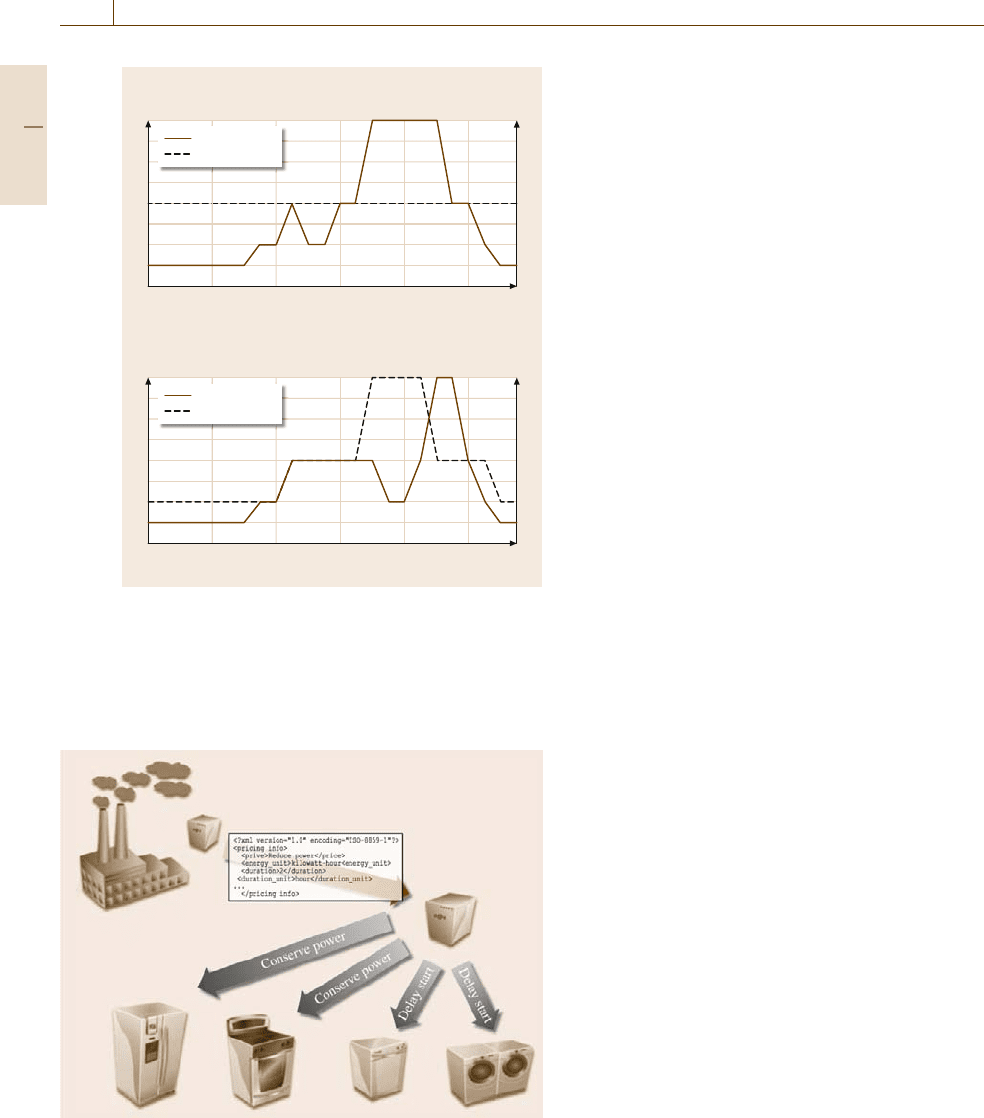Nof S.Y. Springer Handbook of Automation
Подождите немного. Документ загружается.


Automation in Home Appliances 83.2 Application Examples, Guidelines, and Techniques 1475
with the appliance itself making all necessary deci-
sions about time and temperature, thus automating the
process.
In a still more advanced realization of cooking au-
tomation, the cooking appliance would be provided
with detailed cooking instructions by the food itself.
The food’s packaging – a box or wrapper – could be
equipped with an RFID tag which would be read by the
cooking appliance, either as it is placed into the appli-
ance or when it is passed near a sensor manually. This
approach is clearly most feasible in the context of pre-
pared foods. The RFID tag would contain details of the
nature of the food (e.g., its type and weight), cooking
time, and cooking temperature. The only required user
intervention would be selecting the desired doneness, if
applicable, and pressing start, substantially automating
the process. When integrated with temperature probes
and sensors, the cooking appliance could automate the
entire process, from defrosting to cooking, simply tak-
ing the desired meal time as an input.
Extending the concept of a digital recipe to cooking,
the power of the AAN could be leveraged to coor-
dinate the functions of the cooking and refrigeration
appliances and substantially automate food preparation
from end-to-end: The smart fridge would manage the
ordering and inventory of ingredients, while the smart
cooking appliances would manage the cooking based
on XML-encoded instructions(time andtemperature) in
the digital recipe or a similar information classification
protocol (Fig.83.7).
83.2.3 Cleaning
Cleaning appliances – clothes washers, clothes dryers,
and dish washers – again offer a substantial degree of
process automation by their very nature. However, fur-
ther levels of automation are possible. Some examples
are as follows.
Washing appliances – clothes and dish washers – are
optimized by their users according to the nature of the
task at hand. The number of cycles offered by each ma-
chine is limited, and users sometimes utilize only one or
two of the available cycles. Thus, there exists the oppor-
tunity to automate the decision-making process further.
With an appropriate array of sensors – such that the fab-
ric/dish type, volume, and soil level can be assessed –
the washer can automatically optimize its cycle. Among
the variables which can be adjusted are the wash, rinse,
spin, etc. durations, the nature of the chemistry (such
as the detergent type and volume), and optimal water
temperature and volume.
greatrecipes.com
Fig. 83.7 Semiautomated food preparation
In an even more advanced implementation, clothing
and dishes would be equipped with RFID tags which
would inform the appliance as to the nature of the item
as well as specific care instructions. The cleaning appli-
ance could then determine the optimum washing/drying
cycle based on all the contents loaded into the ma-
chine, perhaps suggesting, for example, that certain
items should not be washed together, or should not be
machine washed (or dried) at all (Fig.83.8).
It is easily observable that water-consuming appli-
ances such as clothes washers and dish washers can
cause a substantial drop in household water pressure
during their operation. They can also consume a sub-
stantial portion of the household hot water reserve. The
power of the AAN can be leveraged automatically to
coordinate the operation of water-intensive processes;
for example, the clothes and dish washers can commu-
nicate over the AAN to ensure that they do not both
operate at the same time, and both devices can com-
municate with the water heater to ensure a sufficient
reserve for other water-intensive activities in the home
(Fig.83.9). Both appliances further could be configured
to avoid operation during bathing times.
83.2.4 General Appliance Automation
Thus far we have examined the automation of the
specific processes performed by individual home ap-
pliances. We now examine automation as it pertains
to home appliances in general. Microprocessor con-
trol, sensor arrays, and connectivity enable a number of
generic automation functions in any so-equipped home
appliance. Some possibilities include:
Part I 83.2

1476 Part I Home, Office, and Enterprise Automation
90
80
70
60
50
40
30
20
10
120
100
80
60
40
20
0
–20
–40
RFID
95% cotton, 5% polyester
Machine wash
Warm water
Tumble dry
Read fabric info
Read load level
Modified delicate wash cycle
Dispense 0.5ml detergent
0ml bleach
0.5ml softener
Wash: 14min, 16°C
Rinse: 13min, 7°C
Spin: 10min, 600rpm
0
Modified delicate dry cycle
Heat: 15min, 16°C
15min, cool down
Tumble: 40rpm
1/1
1/2
Fig. 83.8 RFID-based wash cycle optimization
•
Performance monitoring
•
Fault monitoring
•
Software maintenance
•
Consumables monitoring.
Performance Monitoring
Traditionally, poor appliance performance is not de-
tected and acted upon until it degrades to a catastrophi-
cally-low level; for example, a refrigerator evaporator
fan becomes clogged with debris and the fridge fails
to cool effectively and begins to consume inordinate
amounts of energy. As performance continues to de-
grade, the fridge is unable to maintain a sufficiently low
temperature and food spoils, resulting in a risk to the
user’s health. Usually only when this near-fault condi-
tion occurs is the user alerted to the problem. However,
advanced automation techniques permit home appli-
ances to monitor various internal performance metrics
continuously. In our example, this might include:
•
The electric current drawn
•
The condenser fan on time
•
Time during which the cooling chamber exceeds the
desired temperature.
These metrics could be compared against their
long-term average values, or against some factory-
programmed limits. If performance, as determined by
these metrics, degrades below the desired level, the
user or the appliance service center is automatically
alerted – by the appliance – to the need for mainte-
nance (Fig.83.10), thus avoiding a catastrophic outage
and food spoilage.
Fault Monitoring
Similarly, appliance faults which are not preceded by
gradually degrading performance can be acted upon au-
tomatically. Appliances can execute internal diagnostic
testing periodically and can detect when subsystems
Part I 83.2

Automation in Home Appliances 83.2 Application Examples, Guidelines, and Techniques 1477
Starting cycle
Projected water demand: 70l
Okay to proceed?
Active cycle in progress?
Water demand in next 30min?
Delay cycle by 30min
Exceeds peak
hour water
reserve limit?
Refilling the tank?
Water demand in next 30min?
Refilling in progress
Projected usage next 30min: 200l
Active cycle in progress
Projected usage next 30min: 150l
Fig. 83.9 Water usage coordination
fail. This information can both be shown on the appli-
ance’s video display and be reported to the appliance
service center. Armedwith exact knowledgeof thefault,
the responding technician can be dispatched with all
necessary tools and parts, minimizing the time to repair
and the need for a follow-up visit to the user premises.
Critically, large volumes of fault and performance
data – gathered from an appliance vendor’s installed
base – can be aggregated and analyzed to spot trends.
Subcomponents which have unusually high fault rates
can be swapped in the manufacturing process to re-
duce the incidence of the fault in future appliances
(Table 83.2). Similarly, appliances showing trends in
a certain mode of performance degradation can be re-
designed to minimize the likelihood of occurrence in
future units.
Software Maintenance
Once home appliances are functional Internet nodes,
it becomes possible to automate appliance software
maintenance. Just as a home personal computer (PC)’s
operating system and application software are updat-
able automatically viathe Internet, socan anappliance’s
software be updated. As software bugs are discovered,
new loads containing the bug-fix can be pushed out
to the connected appliances, eliminated the need for
a service call, the need to disassemble the appliance,
or even the need to connect tools – such as a PC –to
the appliance. Beyond bug-fixes, this technique can be
used to deploy new software-based functionality, such
as new or optimized machine cycles. This is a partic-
ularly powerful capability when used in conjunction
with the aforementioned large-scale performance data
analysis, which might indicate that certain software pa-
rameters – such as performance thresholds – need to be
tweaked.
Consumables Monitoring
Some home appliances utilize consumable items
– items which have a limited useful life and must be
replaced periodically. Examples include filters and ad-
ditive or detergent cartridges. When an appliance is
Part I 83.2

1478 Part I Home, Office, and Enterprise Automation
Measurement report
Average current: 12.3A
Condenser on time: 4h
Average fridge temperature: 2°C
Average freezer temperature: –15°C
Fridge over-temperature time: 4 h
Freezer over-temperature time: 2.1h
Trouble notification
Maintenance request
Maintenance confirmation
Customer service
back office
Maintenance scheduled
Poor performance detected
Execute remote diagnostics
Measurement report
Compressor efficiency: 38%
Initiate performance monitoring
C
us
tom
er
ser
v
i
c
e
back offic
e
Fig. 83.10 Remote performance monitoring
under microprocessorcontrol, theremaining life of con-
sumables can be monitored precisely. When this metric
falls below a predetermined threshold, the connectivity
capability can be used to reorder the consumable auto-
matically, thus eliminating the possibility of appliance
downtime or degraded performance.
83.2.5 Household Energy Management
For a number of reasons, household energy usage – pri-
marily electric power usage – has been brought to the
forefront of the energy debate. Concerns over climate
change, energy supply stability, and national energy
Table 83.2 Trending using aggregated performance data
Type Subtype Model Revision Units in field Fault code Fault instances
Refrigerator Side-by-side K123 2 67839 1 0
Refrigerator Side-by-side K123 2 67839 2 0
Refrigerator Side-by-side K123 2 67839 3 42
Refrigerator Side-by-side K123 2 67839 4 690
Refrigerator Side-by-side K123 2 67839 5 0
... ... ... ... ... ... ...
independence have refocused government and public
utilities on the issue.
A particular concern of electric utilities is transient
peaks in demand which exceed the utility’s ability to
produce power. In such situations, the utility is forced to
purchase energy on the open market from a third-party
supplier. Since such suppliers know that electric power
in such overload conditions is extremely valuable to the
utility, they charge relativelyhigh prices for the electric-
ity, negatively impacting the utility’s margins, in some
cases to the extent that the utility loses money, after
having sold the electric power for less than it cost to
acquire it.In order to minimize their loss, utilities some-
Part I 83.2

Automation in Home Appliances 83.2 Application Examples, Guidelines, and Techniques 1479
times must cut their supply of power. In order to spread
the pain, this is done for brief periods within a number
of geographic regions, producing the infamous roving
brownouts.
In other industries, if a supplier runs out of capacity,
it simply builds or otherwise procures additional sup-
ply capacity. In the case of a manufacturer of goods,
a new factory might be constructed. However, electric
power generation facilities are both expensive to build
and sensitive politically. So increasing supply is diffi-
cult and sometimes infeasible. In order to address the
electric power supply–demand problem, utilities have
taken a demand-side approach. This approach entails
direct control of power consumption by the electrical
devices – including appliances – in the home, as well
as in load-based, real-time pricing of electricity. Thus
we introduce the concept of automated electric power
usage in the home.
Direct Load Control
Direct load control (DLC) refers to the ability of the
electric power utility to reduce the amount of power
consumed by electrical equipment in the home by
communicating directly with the equipment, without
the need for resident intervention [83.3]. Examples of
home electrics which are key to the DLC strategy in-
clude HVAC systems, electric water heaters, and major
appliances.
With DLC, as the utility approaches its capacity
limit (Fig. 83.11), it sends signals to the home electrics
which indicate the need to conserve power; for exam-
ple, the HVAC system can be requested to operated at
a higher (in summertime) or lower (in wintertime) tem-
perature. Likewise, the water heater can be requested to
Electric utility capacity
Electricity demand
Time
Fig. 83.11 Hypothetical electricity demand versus electric
utility capacity
switch off temporarily, resulting in power savings with
a slight reduction in water temperature. Electrical ap-
pliances – which sometimes have complex operating
cycles – can be requested to operate in high-efficiency
mode, or to delay starting until the power demand has
subsided.
Many architectures exist for realizing DLC-based
automated home energy usage control. In one imple-
mentation, the electric utility operates a server which
monitors instantaneouspowerdemand. As demand con-
tinues to rise toward the utility’s peak capacity, the
server sends signals to smart power meters in partic-
ipating homes, which in turn send signals – perhaps
wirelessly – to the subtending appliances, indicating the
need to conserve power (Fig.83.12).
If the number of participating households is large,
and if the aggregated power savings are sufficient, then
the utility can avoid going to the open market to procure
power and the associated possibility of a brownout. As
demand begins to wane, the utility’s server signals the
smart power meters with a signal indicating that power
consumption can return to normal. Thus, home power
demand control is automated.
DLC ismost applicable in markets where retail pric-
ing is regulated, i. e., real-time pricing is not possible.
Consumers are offered incentives to participate in DLC
programs in the form of rebates from the electric utility.
Real-Time Pricing
Real-time pricing refers to the electric utility’s ability to
vary pricing for electric power over relatively short pe-
riods of time, for example, on a per-hour basis [83.4].
Fig. 83.12 Direct load control using smart power meters
Part I 83.2

1480 Part I Home, Office, and Enterprise Automation
Relative usage
Relative rate
Relative usage
Relative rate
0 4 8 12 16 20
Relative usage
Home electricity usage, flat-rate pricing
Hour of day
8
7
6
5
4
3
2
1
0
4
3
2
1
0
0 4 8 12 16 20
Relative usage
Home electricity usage, real-time pricing
Hour of day
8
7
6
5
4
3
2
1
0
4
3
2
1
0
Fig. 83.13 Home electricity usage: flat-rate versus real-
time pricing
Real-time pricing can be used – among other things –
to disincentivize power consumers from using power
during periods of peak demand. This reduces the prob-
Fig. 83.14 Real-time pricing using appliance control node
ability that the utility’s own capacity will be exceeded,
and minimizes the likelihood that the utility has to pur-
chase additional power on the open market.
When real-time pricing information is relayed to
consumers, they make decisions about how to use their
home electrics so as to keep their electric bill within
their spending limits. So, for example, during peak
hours in summertime, residents can choose to set ther-
mostats to a higher temperature in the mid-afternoon,
when energy prices are highest. Likewise, certain
household activities – such as laundry and dish wash-
ing – can be deferred until pricing is more amenable
(Fig.83.13). With enough participating households, the
aggregated power demand on the utility is eased to the
point that it does not have to purchase additional power
from a third party.
We have described a mechanism by which electric
utilities can automate demand control by manipulat-
ing the retail price of power. However, further power
consumption automation opportunities exist on the con-
sumer side. If the pricing information is relayed directly
to appliances – for example, via a smart meter – then
compatible appliances can automatically adjust their cy-
cles so as to minimize the net energy cost; for example,
the clothes washer, after having received a start signal
from the user, could delay starting its cycle until energy
prices are more favorable.
Alternatively, if pricing information is relayed to
a hypothetical appliance control node located in the
home, the control node can schedule appliance (and
HVAC, water heater, etc.) operation so as to meet
consumer-configured criteria regarding comfort, conve-
nience, and cost (Fig.83.14).
For example, the user could decide that he wants to:
1. Minimize cost during weekdays
2. Balance cost with comfort and convenience during
weeknights
3. Maximize comfort and convenience on weekends.
The control node would then configure and sched-
ule tasks accordingly. This could mean, for example,
switching off the air conditioning during weekdays,
raising the temperature slightly on weeknights, and op-
erating it normally all weekend.
A more sophisticated energy control node algorithm
might look something like that shown in Table 83.3.
Thus the user can achieve the optimal balance of
electric power cost and comfort and convenience in an
automated way.
Part I 83.2

Automation in Home Appliances 83.3 Emerging Trends and Open Challenges 1481
Table 83.3 Appliance energy control node algorithm
A/C Water heater Clothes washer Clothes dryer Dish washer Fridge
Weekdays Temperature: Temperature: Deferred Deferred Deferred High efficiency
high price −6.67
◦
C −6.67
◦
C operation operation operation
Weekdays Normal Normal High efficiency High efficiency High efficiency Normal
low price
Weekends Temperature: Temperature: High efficiency High efficiency Deferred Normal
high price −16.1
◦
C −12.2
◦
C
Weekends Normal Normal Normal Normal Normal Normal
low price
83.3 Emerging Trends and Open Challenges
83.3.1 Trends
Display Devices
Advancements in home appliance automation are driv-
ing – and are enabled by – advancements in display
devices. More and more appliances are available with
advanced light-emitting diode (LED), monochrome
liquid-crystal display (LCD), and full-color LCD dis-
play devices (Fig. 83.15). These user interfaces (UIs)
facilitate the richer user experience required for ad-
vanced status and control (input/output, I/O) functions,
such as those required by advanced automation tech-
niques.
For example, with either the DLC or real-time pric-
ing modes of energy management, the appliance user
must be informed of in-process energy management ac-
tivities. In the case of DLC, the user must know when
the utility is actively managing the appliance. For real-
Fig. 83.15 Appliance I/O device evolution
time pricing, the user needs to be apprised of the current
price of power. In either case, the user must have the
ability to control the appliance’s behavior. A user might
want to override DLC or the real-time pricing program
if some process, e.g., laundry, needs to be performed
immediately due to some immanent need. All of these
functions required the rich I/O facilities whichadvanced
display devices provide.
Interconnectivity
Most advanced appliance automation techniques re-
quire remote transmission of information to, or remote
retrieval of information from, the appliance. This im-
plies that appliances must interconnected – to each
other, and most importantly to the Internet. Household
energy management, remote performance analysis and
fault detection, and remote software maintenance are
all critically dependent on interconnectivity. Thus, in-
Part I 83.3

1482 Part I Home, Office, and Enterprise Automation
terconnectivity is emerging as a major area of research
and development in the home appliance industry.
Smart Resource Usage
We have discussed at length the initiatives on the front
of home appliance automated electric power conserva-
tion. While home appliances become more convenient,
they are simultaneously becoming more efficient and
more intelligent in their use of electricity, the culmina-
tion of which being automated energy management.
Beyond electricity, questions about supply and price
of water and natural gas are driving improvements in
efficiency on those fronts. From the user’s perspec-
tive, such savings are automated, realized internally by
advanced software algorithms, mechanical techniques,
and materials within the home appliance.
83.3.2 Challenges
Retail Cost
Home appliances are consumer products and, as such,
are highly dependent on sales volumes. In some cases,
an appliance only becomes profitable to produce if hun-
dreds of thousands – or millions – of units can be sold.
Competition is fierce and only grows more intense as
time goes on. Thus, tremendous efforts are put into
minimizing costs.
All the technology presented here – sensors, dis-
plays, and communication electronics – add cost to
the appliance. This creates a significant barrier to the
introduction of such advancements on a large-scale ba-
sis. Consider that a mere dollar of additional cost to
an appliance could result in the loss of hundreds of
thousands of dollars of revenue for the manufacturer.
(Note that retail prices are set by the market, not by the
manufacturer, so additional manufacturing costs cannot
necessarily be passed onto the consumer.)
Thus, costs represent a significant challenge to
the deployment of advanced automation techniques in
home appliances. Whereas the value of having – say
– a clothes washer is obvious to most consumers, the
value of having an interconnected washer is less so. The
home appliance industry is thus tasked with convincing
consumers that the added value provided by advanced-
automation appliances justifies the incremental cost.
Personal Control and Privacy
Consumers are used to having full control over their ap-
pliances: When the start button is pressed, the machine
should start operating. Advanced automation requires
that users cede some of this control either to the lo-
cal machine or to some other remote device. Consumer
acceptance ofthis paradigmwill require significant edu-
cation on the part of appliance manufacturers.It islikely
that, in order to achieve consumer acceptance, the ulti-
mate control for appliance behavior will have to remain
in the hands of the consumer, with the appliance and
other control systems simply providing suggestions for
machine operation.
Further, the introduction of interconnectivity might
present privacy concerns. It is not clear whether con-
sumers would be receptive to the notion of their home
appliances automatically relaying information to the In-
ternet, nor to the idea of an Internet node (e.g., the
electric utility) remotely accessing information in their
appliances. In order to gain consumer acceptance, appli-
ance manufacturers willneed toassure consumersof the
nature and security of the information being exchanged.
This will almost certainly involve using common In-
ternet information security techniques to ensure data
privacy.
Standardization and Interoperability
Particularly in the case of interconnectivity, stan-
dard implementation methods are required. If, for
example, the electric utility is to implement DLC,
it is not practical for the utility to use a dif-
ferent communication protocol for each appliance
vendor and each appliance model. Further, in the
case in which appliances from different vendors
within a single home must communicate with each
other, the appliances cannot be expected to know
each other’s proprietary protocols. In sum, a uni-
versal communication protocol is required. At the
time of this writing, standardization efforts are un-
derway both within the International Electrotechnical
Commission (IEC) and within the Association of
Home Appliance Manufacturers (AHAM) on this topic.
The outcome should be a standard for home ap-
pliance communication that permits full intervendor
interoperability.
Part I 83.3

Automation in Home Appliances References 1483
83.4 Further Reading
•
V.V. Badami: Home appliances get smart, IEEE
Spectrum 35(8), 36–43 (1998)
•
P. Bertoldi, A. Ricci, A. de Almeida: Energy
Efficiency in Household Appliances and Lighing
(Springer, Berlin Heidelberg 2001)
•
R.Kango, P.R. Moore, J. Pu: Networked smart home
appliances – enabling real ubiquitous culture, IEEE
5th Int. Workshop Netw. Appl. (2002) pp. 76–
80
•
K.J. Myoung, J.M. Lee, D.-S. Kim, W.H. Kwon:
Home network controlprotocol fornetworkedhome
appliances, IEEE Trans. Consumer Electron. 52(3),
802–810 (2006)
•
J. Nicholls, B.A. Myers: Controlling home and of-
fice appliances with smart phones, IEEE Pervasive
Comput. 5(3), 60–67 (2006)
•
Y. Tajika, T. Siato, K. Teramoto, N. Oosaka,
M. Isshiki: Networked home appliance system
using Bluetooth technology integrating appliance
control/monitoring with internet service, IEEE
Trans. Consumer Electron. 49(4), 1043–1048
(2003)
References
83.1 US Energy Information Administration,
http://www.eia. doe.gov
83.2 J.C. Gallawa,
http://www.gallawa.com/microtech/history.html
83.3 Pacific Northwest Demand Response Project,
http://www. nwcouncil.org/energy/dr
83.4 Federal Energy Regulatory Commission: Assessment
of demand response and advanced metering 2007
staff report (2008), http://www.ferc.gov/
industries/electric/indus-act/demand-response/
dem-res-adv-metering.asp#skipnavsub
Part I 83
“This page left intentionally blank.”
